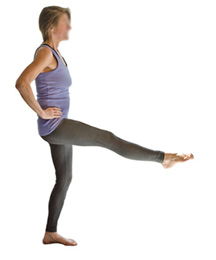
Posture:Hasta–pada–angusta–asana–The Hand–Foot–Big Toe Pose
Translation:The Sanskrit word hasta means hand, pada means foot, and angusta means big toe therefore this is the hand-foot-big toe posture.
Pronunciation:ha-sta-pah-don-goo-stah-sa-na
Difficulty:(3)
Instructions:
- Sit on the floor with the legs together and extended straight out in front. Keep the back straight, shoulders level and head straight. Place the hands, palms down, flat on top of the thighs.
- Spread the legs as far apart as possible without bending the knees.
- Bend the left knee and place the bottom of the left foot against the inner left thigh. Bring the left heel as close to the perineum as possible. Keep the left knee on the floor.
- Stretch both arms straight out in front of you, then keeping the back straight turn slowly at the waist toward the right aligning the arms with the right leg.
- Inhale slowly while raising the arms over the head and arching the back.
- Exhale and slowly while bending forward bringing the chest down to the right thigh. Clasp the big toe of the right foot with the first finger of both hands. Hold this position for the duration of the exhaled breath.
- Inhale slowly through the nostrils releasing the posture while sitting up straight.
- Straighten the left leg and return to the seated position described in step 2 then repeat the posture, this time bending the right leg.
Comments:
The benefits of the hasta-pada-angusta-asana are similar to those of the ugra-asana (i.e.: spinal stretch,abdominal toning, gastro-intestinal stimulation). There is additional stretching of the leg that is outstretched as well as to the groin.
Duration/Repetitions:
Repeat two or three times on each leg.


